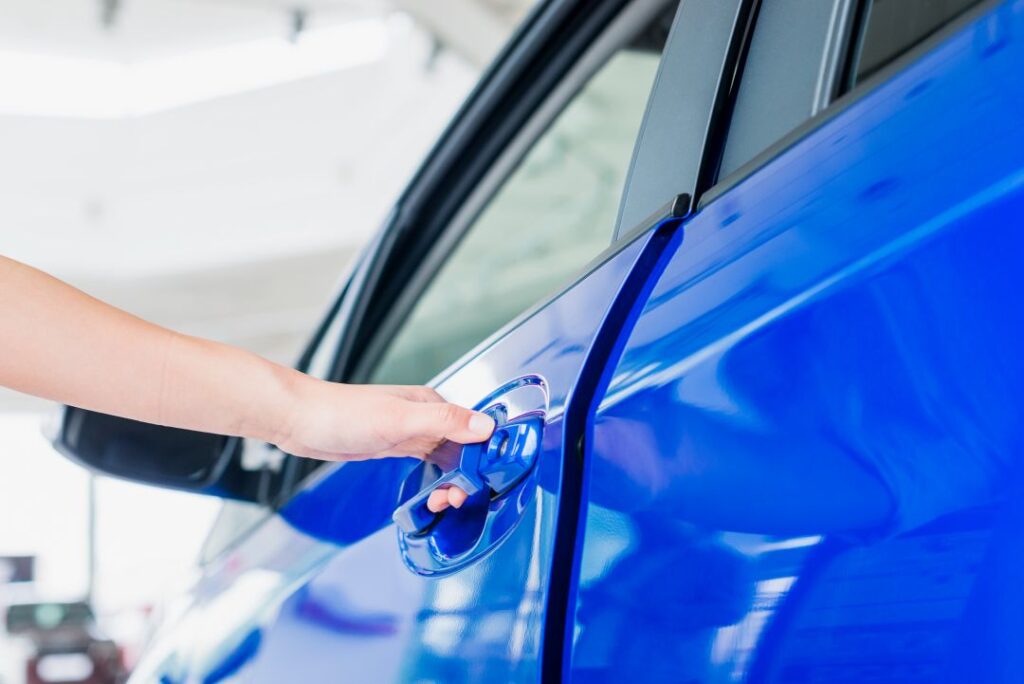In recent years, the automotive customization world has witnessed a striking trend: the surge in popularity of blue wrapped cars. This phenomenon has captured the imagination of car enthusiasts and casual observers alike, transforming ordinary vehicles into rolling works of art that command attention on streets and highways.
The rise of blue wrapped cars represents more than just a color preference; it’s a statement of individuality, a reflection of current design trends, and a testament to the evolving technology of vehicle customization.
The allure of blue car wrapping lies in its versatility and visual impact. From deep navy hues that exude sophistication to electric blues that pop with energy, the spectrum of blue offers something for every taste and style.
This wide range of options has contributed significantly to the growing popularity of blue wrapped cars, allowing owners to express their personalities through their vehicles in ways that were once limited to expensive custom paint jobs.
You May Like: A Comprehensive Guide About Car Wraps
The process of blue car wrapping involves applying a thin, flexible vinyl film over the vehicle’s original paint. This technique offers several advantages over traditional painting methods.
For one, it’s reversible, allowing car owners to experiment with bold designs without permanently altering their vehicle’s appearance. Additionally, the wrap protects the underlying paint, potentially preserving the car’s resale value.
One of the key factors driving the trend of blue wrapped cars is the advancement in wrap technology. Modern vinyl wraps are more durable, easier to apply, and come in a wider variety of finishes than ever before. Matte, gloss, satin, and even color-shifting blues are now available, giving car owners unprecedented options for customization. These technological improvements have made blue car wrapping more accessible and appealing to a broader audience.
The rise of social media has also played a crucial role in popularizing blue wrapped cars. Platforms like Instagram and YouTube have become showcases for stunning vehicle transformations, with blue wraps often taking center stage. The visual appeal of a sleek, blue-wrapped vehicle against urban or natural backdrops makes for compelling content, further fueling the trend and inspiring others to consider this customization option.
Car wrap insights from industry experts suggest that the blue trend isn’t just about aesthetics; it’s also about psychology. Blue is often associated with trust, stability, and confidence – qualities that many people want to project through their vehicles. This psychological aspect adds depth to the trend, indicating that the choice of blue goes beyond mere visual preference and taps into deeper emotional and social factors.
The cost associated with wrapping a car in blue can vary widely depending on factors such as the size of the vehicle, the quality of the vinyl used, and the complexity of the design.
Generally, a full wrap for a standard-sized car can range from $2,000 to $5,000 or more. While this represents a significant investment, many car owners find it more cost-effective than a high-quality custom paint job, especially considering the added benefit of paint protection.
The time required to wrap a car is another important consideration for those contemplating this customization. A professional installation typically takes between three to five days, depending on the complexity of the wrap and the vehicle’s shape. This relatively quick turnaround time is another factor contributing to the popularity of blue wrapped cars, as owners can transform their vehicles without enduring lengthy periods without their cars.
For those wondering how much wrap is required to wrap a car, the answer depends on the vehicle’s size and the intricacy of the design. On average, a full wrap for a standard car requires about 50 to 75 square feet of vinyl. However, it’s always advisable to have extra material on hand to account for errors or challenging areas of the vehicle.
The environmental impact of blue wrapped cars is another aspect worth considering. Vinyl wraps are generally less harmful to the environment than traditional paint jobs, which involve harsh chemicals and produce more waste. Additionally, the protective nature of wraps can extend the life of a vehicle’s original paint, potentially reducing the need for repainting and the associated environmental costs.
The trend of blue wrapped cars has also influenced the automotive industry beyond personal vehicles. Commercial fleets and corporate vehicles are increasingly adopting blue wraps as part of their branding strategies. The bold, professional appearance of a well-executed blue wrap can enhance a company’s image and increase brand recognition on the road.
As the popularity of blue wrapped cars continues to grow, we’re seeing innovative applications of the technology. Some enthusiasts are experimenting with combining different shades of blue in a single wrap, creating gradient effects or intricate patterns. Others are incorporating blue as part of larger, more complex designs that include other colors and graphic elements.
The future of blue car wrapping looks bright, with ongoing advancements in materials and application techniques promising even more exciting possibilities. Researchers are developing wraps with enhanced durability, self-healing properties, and even color-changing capabilities activated by temperature or electrical current. These innovations could take the trend of blue wrapped cars to new heights, offering even more dynamic and personalized options for car owners.
However, the rise of blue wrapped cars is not without its challenges. As the trend grows, concerns about quality and craftsmanship have emerged. Not all wraps are created equal, and poor-quality materials or improper installation can lead to bubbling, peeling, or fading. This has led to an increased emphasis on professional installation and the use of high-quality vinyl, ensuring that blue wrapped cars maintain their stunning appearance over time.
The legal landscape surrounding vehicle wraps is another area of consideration. While generally permissible, some jurisdictions have specific regulations regarding vehicle color changes, especially for cars that were originally a different color. It’s important for owners of blue wrapped cars to be aware of local laws and potentially notify their insurance providers of the modification.
In conclusion, the rise of blue wrapped cars represents a fascinating intersection of technology, design trends, and personal expression. From the deep blues of luxury vehicles to the bright, eye-catching wraps on sports cars, this trend has transformed the way we think about vehicle customization. As materials continue to improve and creative applications evolve, we can expect to see even more innovative and stunning blue wrapped cars on our roads.
The blue car wrapping phenomenon is more than just a passing fad; it’s a reflection of our desire for individuality and our appreciation for the transformative power of design.
Whether you’re a car enthusiast looking to make a statement or a business owner seeking to stand out, the world of blue wrapped cars offers endless possibilities. As we look to the future, one thing is clear: the azure aspirations of car owners and designers alike will continue to push the boundaries of what’s possible in vehicle customization.




Pingback: Stunning Cars Wrapped in Chrome: The Ultimate Guide to Eye-Catching Vehicle Wraps – Car Wrap Insights
Pingback: Stunning Cars Wrapped in Chrome: The Ultimate Guide to Eye-Catching Vehicle Wraps - Car Wrap Insights